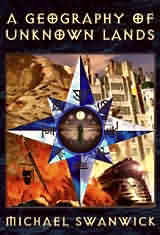- Bones of the Earth
- Bones of the Earth
- Bones of the Earth
- A Geography of Unknown Lands
- Gravity's Angels
- Griffin's Egg
- The Iron Dragon's Daughter
- Jack Faust
- Moon Dogs
- Tales of Old Earth
![]()
Review by Nick Gevers
(This review first appeared in Parsec, 1998)
A Geography of Unknown
Lands
Frog Ltd./Tachyon (USA), 2000
Michael Swanwick's second collection, A Geography of Unknown
Lands (1997), is like a master class in literary alchemy. Here
is a chunk of rusty old schlock, says Swanwick the magus: consider
its core of derivativeness, its outcrops of cliché, its tired absence
of sheen.

Now see: if I add a pinch of radical deconstruction, throw in some powdered contemplation and cunning, and re-orient the chunk in time, we obtain in its place a polished, insinuating, and elegiac golden ingot. In this book (to stop putting words in Swanwick"s very articulate mouth) such transformations are wrought with a by now routine brilliance. In Swanwick's four magisterial novels, Vacuum Flowers (1987), Stations of the Tide (1991), The Iron Dragon's Daughter (1993), and Jack Faust (1997), as well as his earlier collection, Gravity's Angels (1991), he demonstrated an unerring command both of the narrative basics of SF and Fantasy and of the means to convert those basics into the stuff of startlingly novel, and deeply meditative, intellectual entertainments. A Geography confirms and showcases this craft.
Two SF stories begin the volume. "The Wireless Folly"
is the history of SF in 5 pages: the genre is summed up in the form
of a mock-architectural report, which describes an old structure
to which new wings and accretions (schools and subgenres) are constantly
added. "Mother Grasshopper" then strikingly pictures the cosmos-conquering
arrogance of traditional American SF as an escapist folksy veneer
painted over the eyes of a gargantuan (and drifting) interstellar
grasshopper. The Midwest has dared to colonize the alien; Death
himself steps in to stymie such hubris. And now Fantasy comes under
similar ironic scrutiny. In "North of Diddy-Wah-Diddy", a caustic
and bluesy novelette, the clichés of supernatural horror and of
the traditional afterlife succumb literally and aesthetically to
the ethic of individual integrity, as the staff on a train to Hell
defy the joint injustice of God and Satan. Perhaps even the dead
can achieve political liberation! "The Edge of the World" brings
modern teenagers, complete with drugs and despair, into the never-never
lands of Lord Dunsany, the Edwardian fantasist; Dunsanian escapism
gives way to a bleak but still sorcerous modernity. "Radio Waves"
paints the spirits of the dead as decaying signals, electrical remnants
facing surreal predators and experiencing dispiriting epiphanies;
they must ultimately fall into the sky, joining the universal background
radiation, in a negation of the conventional ghost story. And "The
Changeling's Tale" is a superb and scathing summation of the Matter
of Tolkien, in which old-style Fantasy is a theft of time and of
life and yet is still to be yearned after. Together, these six stories
are a denunciation of their genres; yet they remake them, in a splendid
creative alchemy. A Geography suggests strongly that Swanwick
is the most significant short story writer active in SF and Fantasy
at present; with their witty but dark revisionist potency, Swanwick"s
tales are unique, and uniquely brilliant.